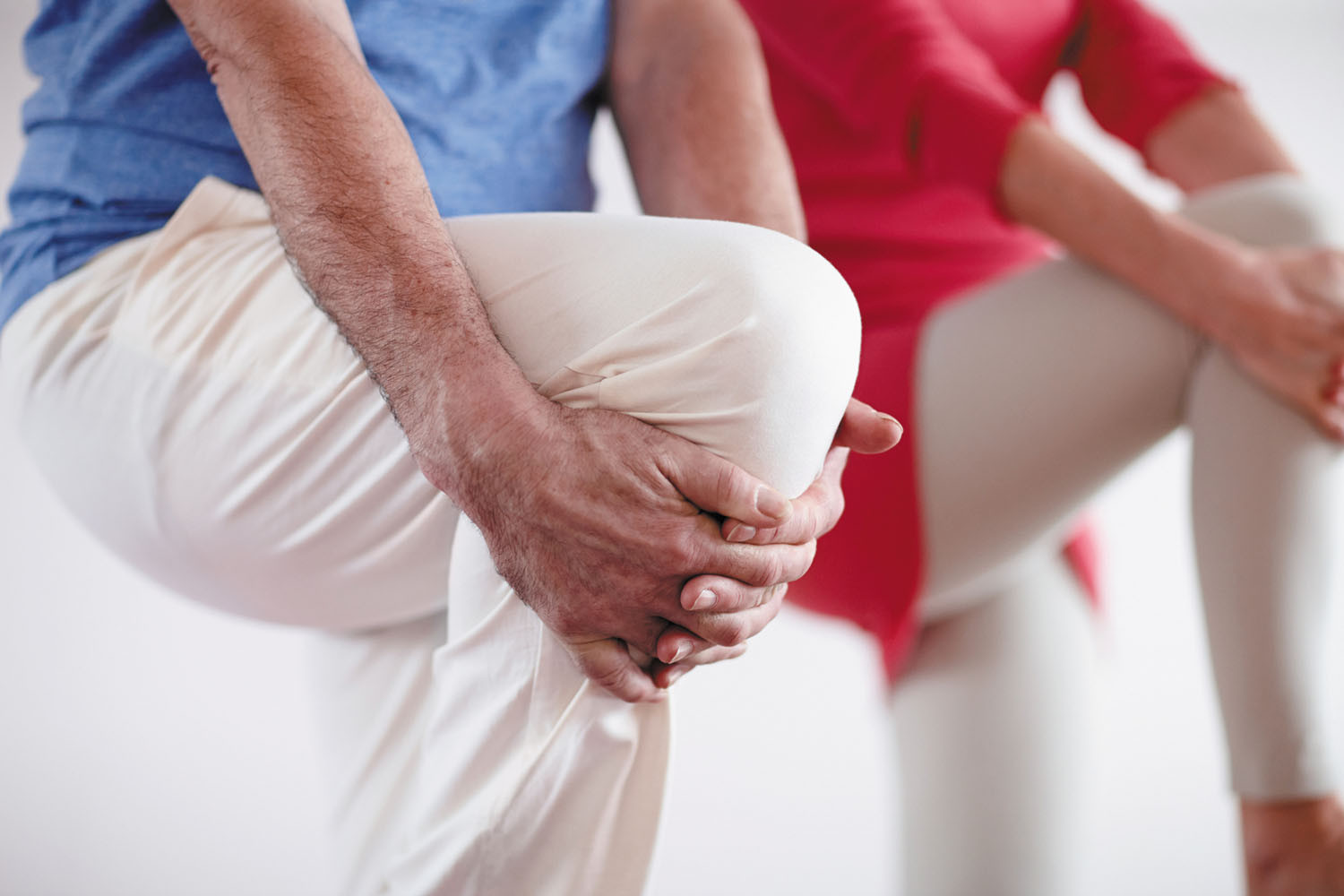
Counting steps is good — is combining steps and heart rate better?

Appendix pain: Could it be appendicitis?

Can saw palmetto treat an enlarged prostate?

How does Ozempic work? Understanding GLP-1s for diabetes, weight loss, and beyond

Zinc: What it does for the body, and the best food sources

Respiratory health harms often follow flooding: Taking these steps can help

Tips to leverage neuroplasticity to maintain cognitive fitness as you age

Can white noise really help you sleep better?

Celiac disease: Exploring four myths

What is prostatitis and how is it treated?
Exercise & Fitness Archive
Articles
Midlife fitness linked to less dementia later in life
Research we're watching
Image: © radyreese/Getty Images
High cardiovascular fitness during middle age may lower the likelihood of dementia late in life, according to a decades-long study.
For the study, researchers asked 191 middle-aged women to ride an exercise bike until they were exhausted. They then grouped the women according to their peak cardiovascular capacity. Just 40 women met the criteria for high fitness, while 92 were in the medium category, and 59 were in the low category.
A personalized approach to preventing Alzheimer’s disease
These strategies may offer greater protection.
Image: © shapecharge/Getty Images
While there's no cure for Alzheimer's disease, ongoing research has suggested there may be ways to lower your risk.
"Much of the existing science supports how certain behavioral changes made in middle age can protect people as they grow older," says Dr. Kirk Daffner, director for the Center for Brain/Mind Medicine at Harvard-affiliated Brigham and Women's Hospital. "However, there is evidence that adopting certain healthy lifestyle habits can benefit older adults too."
Mini workouts can add up to better health
Research we're watching
Image: © RoBeDeRo/Getty Images
Good news for people who struggle to find time for exercise: every little bit matters, even if your "workout" is broken up throughout the day. To come to this conclusion, researchers who published their results March 23 in the Journal of the American Heart Association looked at data from 4,840 people ages 40 and older who participated in the National Health and Nutrition Examination Survey from 2003 to 2006. People who spent the shortest amount of time in moderate or vigorous activity — 20 minutes or less daily — had the highest risk of dying during the roughly six-year follow-up period. But those who got at least an hour of moderate or vigorous activity cut that risk in half, and those who got at least 100 minutes a day cut their death risk by 76%. And they didn't have to get those 100 minutes all at once. Even short bursts of activity at different points in the day added up to reduced risk.
Obesity is complicated — and so is treating it
Along with the growing realization that obesity is a complex disease comes greater understanding that treatments need to be highly individualized and address the physical and emotional factors that contribute to it.
Are weight-loss drugs worth trying?
Image: Bigstock
Newer medications, which may be safer than earlier drugs, have expanded the options for treating obesity.
Obesity is now considered more than a risk factor for other conditions; it's a disease itself. It has been the subject of intense scientific and medical research to develop effective treatments. But the quest has been elusive.
How should core work fit into your overall exercise plan?
Your core muscles are the sturdy link between your lower body and upper body. Every move you make starts in your core or transfers through it. So, a weak or tight core can translate into less power from your arms and legs.
It's well worth including core work in your exercise plan. The Physical Activity Guidelines for Americans from the U.S. Department of Health and Human Services recommend the following well-rounded plan:
A breathing technique to help you relax
The practice of yoga incorporates many separate breathing techniques (above and beyond the coordinated breathing you do during yoga routines) that can help relax you and release tension. And many of these techniques can be done anytime, anywhere — not just during yoga class.
If you'd like to reap the benefits of these breathing techniques, start with the abdominal breathing technique described below. Once you've mastered abdominal breathing, you can then try others based on the unique benefits that each technique offers.
Balancing act
Falls continue to be the leading cause of injuries among older adults. Practicing balance exercises can help keep you steady.
Image: © laflor/Getty Images
Every year, about one-quarter of adults older than age 65 experience at least one accidental fall. The impact of a fall can be devastating. About 20% of falls result in a serious injury like broken bones in the wrist, arm, and ankle; hip fractures; and head injuries. Surgery or rehabilitation may be needed, which may impair your mobility. A fall also could cause psychological trauma and make you fearful of being active.
"You want to do whatever you can to avoid a fall," says Dr. Adam Tenforde, a sports medicine physician at Harvard-affiliated Spaulding Rehabilitation Hospital.
Overcoming your barriers to exercise
Find ways to be more active — even if you have sore joints or other limitations.
Image: © Cecilie_Arcurs/Getty Images
You're probably well aware that exercise is the best way to keep your heart strong and healthy. Any activity that moves your muscles will raise your heart rate, making it better able to pump blood through your body. Over time, exercise enables your heart to beat slower and keeps your blood pressure under control.
But many people don't exercise regularly. Just over half of adults in the United States meet the recommended physical activity guidelines (see "Weekly physical activity goals"). Two of the main reasons people say they don't exercise are (1) not having enough time and (2) having joint pain, fatigue, or a chronic health condition.
Treatments for breast cancer may harm the heart
But surveillance and other strategies — especially exercise — can limit the risk.
Image: © Khuong Hoang/Getty Images
Better treatments for breast cancer have contributed to the growing number of breast cancer survivors, now about three million in the United States. However, these women may face a heightened risk of heart disease from the cardiotoxic effects of chemotherapy and radiation, according to a statement from the American Heart Association in the Feb. 20, 2018, issue of Circulation.
Doctors have long known that certain cancer drugs can decrease the heart's pumping ability, especially doxorubicin (Adriamycin) and trastuzumab (Herceptin), two common treatments for breast cancer. Many women receive radiation therapy as well, which can cause heart tissue to scar or stiffen, possibly leading to valve disorders, coronary artery disease, or other heart problems. But specialists who focus on keeping the heart healthy during and after cancer treatment — known as cardio-oncologists — can offer strategies to both prevent and treat heart damage from cancer therapy.

Counting steps is good — is combining steps and heart rate better?

Appendix pain: Could it be appendicitis?

Can saw palmetto treat an enlarged prostate?

How does Ozempic work? Understanding GLP-1s for diabetes, weight loss, and beyond

Zinc: What it does for the body, and the best food sources

Respiratory health harms often follow flooding: Taking these steps can help

Tips to leverage neuroplasticity to maintain cognitive fitness as you age

Can white noise really help you sleep better?

Celiac disease: Exploring four myths

What is prostatitis and how is it treated?
Free Healthbeat Signup
Get the latest in health news delivered to your inbox!
Sign Up











